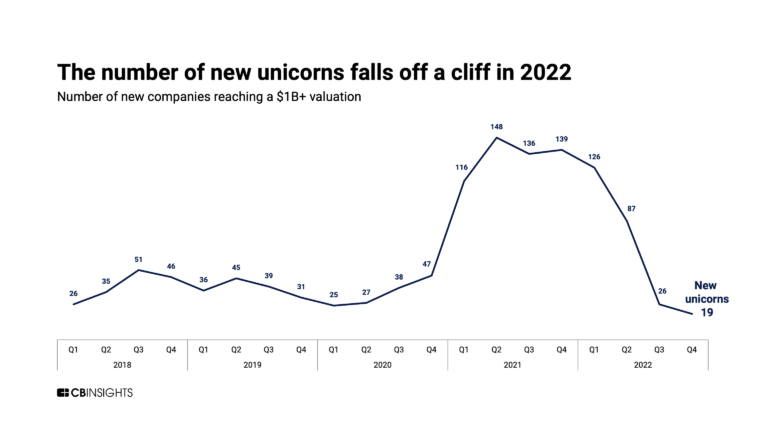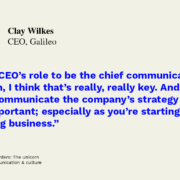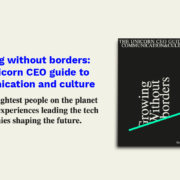Unicorn Club turmoil: Dehorned unicorns and VCs pullback
In 2021, 539 companies achieved unicorn status. Yes, you are reading that right. Five hundred and thirty-nine companies achieved a valuation of more than $1 billion. In other words, the once rara avis started popping up like hot cakes, at a rate of almost 1.5 unicorns a day. To put this in context, almost four times as many unicorns were minted in 2021 as in 2020 (137 in total). What’s more, that figure was 20% more than the unicorns minted in the previous three years: 446 new unicorns between 2018 and 2020.
2022 began with the same cadence of unicorn growth, with 126 in the first three months of the calendar year. At the height of the boom, the unicorn club surpassed 1,000 members for the first time in February last year. Then suddenly we saw a recognisable shift in frequency. There were 87 in Q2, 26 in the following quarter and only 19 in the last three months of the year. In other words, 258 new unicorns. A much higher figure than in any year prior to 2021, but a far cry from that of 2021 with a progressive drop quarter by quarter. The golden days when the money of VCs flowed uninhibited were over and instead, they tightened their belts in a context marked by macro trends such as inflation, rising interest rates and geopolitical crisis. Not only was this evident in the slowdown in the emergence of new unicorns, many of those already in the stable felt the brunt of drastic reductions in their valuations; to the point where some of them lost their horns.

Unicorns minted every quarter between 2018 and 2022 – Source: CB Insights
The Unicorn Club in 2022 in figures
2022 was a year in which the stable was revolutionised. There is no doubt about that, as anyone working in the technology sector will know. For us, as an agency at the intersection of technology, science and innovation, it is imperative to remain informed with these types of companies as many of them are revolutionising industries and creating solutions to some of society’s biggest challenges. Remote, Workato, ClickUp or Immuta are among some of the amazing brands we work with. We pride ourselves on being great researchers of these types of fast-growing companies and enjoy learning about their journeys, their challenges and their practical advice. We have interviewed more than 30 unicorn leaders in our podcast – you can listen to all the episodes here – and we have published a practical guide summarising the main communication and culture tips we have learned during the first fifteen episodes with these inspiring entrepreneurs. We will soon be publishing the second edition with learnings and key takeaways from the most recent episodes, so keep an eye out for that!
While there are multiple sources for information on this large group of organisations, we tend to rely on the data compiled by CB Insights. Earlier this year they published an updated version of the Unicorn Club as of 31st December 2022 (at the end of the article you will find an infographic with all the companies divided into 15 technology sectors). After diving into the data, these are the main trends we would like to highlight.
The 3,800 trillion-dollar club
The Unicorn Club is made up of 1,205 companies with a combined value of $3.86T. Currently only three companies exceed the $100B+ barrier (ByteDance, SpaceX and SHEIN). At the opposite end of the spectrum are 22.4% of the companies on the list, with a valuation of exactly $1B. After what we have seen in recent months with the readjustment of valuations for many unicorns, it is foreseeable that quite a few of these companies will have to leave the club.
The world’s most valuable unicorns
Of the hundreds of companies in the club, Chinese company ByteDance holds the honour of being the world’s largest unicorn, with a valuation of $140B. It is followed in the ranking by SpaceX, SHEIN, Stripe and Canva.
The top 10 is dominated by three countries. Half of these companies are American – in addition to the aforementioned SpaceX and Stripe, Instacart, Databricks and Epic Games who are all among the world’s most valuable startups. China (ByteDance and SHEIN) has two companies at the top of this list, as does the UK (Checkout.com and Revolut). Australia’s Canva completes the top 10.
The US dominates the club
The top 10 is a representative sample of what is happening among the more than 1,200 unicorns in existence. Although unicorns originate from 47 countries, just over half of the companies are from the United States (54%), with China a distant second (14.3%). Rounding out the top 5 are India (5.8%), the UK (4.1%) and Germany (2.4%).
Fintech and Internet software & services, the preeminent categories
Four out of ten unicorns belong to the Fintech (20.9%) or Internet software & services (18.9%) categories. In the Fintech sector, companies such as Ripple and Plaid stand out in addition to the aforementioned Stripe, Checkout.com and Revolut.. Canva, Miro, OpenSea and Grammarly are some of the companies with the highest valuation in the Internet software & services category.
The third most represented category is e-Commerce & direct-to-consumer (9%), among which SHEIN and Fanatics stand out. It is closely followed by Health (8%), a sector in which the main unicorns are the US companies Devoted Health and Biosplice Therapeutics.
The veterans of the club
As I mentioned at the beginning of this article, a remarkable number of unicorns emerged in 2021. Of the 539 that joined the club, 524 remain in it today. But who is the longest-serving member of the club, and how many have been members of this select group of private companies for more than a decade?
The French company Veepee holds the honour of being the longest-serving company in the club. It achieved that status in mid-2007 and is currently valued at $1.38B.
Only seven companies have been unicorns for more than ten years. After Veepee, the oldest members of the stable include Klarna and Vice Media (joined in 2011). In 2012, SpaceX, Fanatics, Avant and Trendy Group International joined the club.
As new funding shrinks, tech companies expect more bang for their buck
2022 has been a difficult year for a number of companies that were growing at a fast pace. In recent months many of them have had to make adjustments (sadly including layoffs) to adapt to market dynamics and, above all, to the reduced amount of funding available.
“Doing more with less” has become the business mantra of today, forcing every company to make the most of every dollar/euro/pound invested. This is something we discuss on an ongoing basis with our current clients and our prospective clients. The words that come up most often during these discussions are “efficiency” and “flexibility”. Essentially, clients find that under the current pressure from investors, every communication activity must deliver the highest added value and in an environment with changing priorities, it is essential for them to partner with an agency that is able to adapt quickly. What we often hear as well is that this is a leading reason as to why our current clients choose to stay with us and why prospective clients decide to embark on a new communications journey with Tyto. Our distinctive PRWithoutBordersTM operating model is purpose-built for flexibility, efficiency and agility, allowing us to deliver 30% more value for the same budget with one single team in multiple markets operating without silos. Our model ensures that clients get more bang for their buck, whether it’s via media relations or broader content marketing actions. Our budgets are unique and not split between different entities or country teams, meaning we can change routes nimbly depending on the tailored and specific needs of our clients. We anticipate that 2023 will be a year of adaptation for further growth for many companies and we are uniquely positioned to achieve the best communication results in Europe for the most innovative brands out there.

The global unicorn club market map (as of 31st December 2022) – Source: CB Insights











